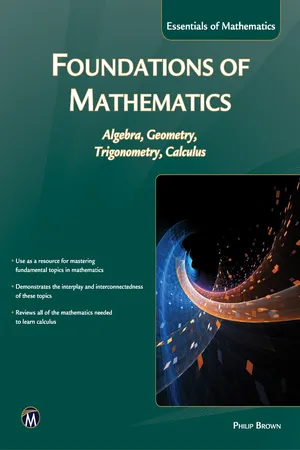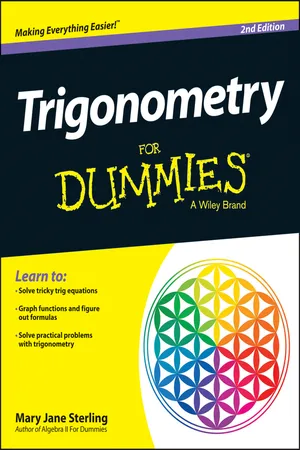Mathematics
Derivatives of Inverse Trigonometric Functions
The derivatives of inverse trigonometric functions are used to find the rate of change of an angle with respect to a variable. They are derived using the chain rule and involve the use of trigonometric identities. The derivatives of inverse trigonometric functions are important in calculus and are used in various applications such as physics and engineering.
Written by Perlego with AI-assistance
Related key terms
Related key terms
1 of 4
Related key terms
1 of 3
4 Key excerpts on "Derivatives of Inverse Trigonometric Functions"
- eBook - ePub
Foundations of Mathematics
Algebra, Geometry, Trigonometry and Calculus
- Philip Brown(Author)
- 2016(Publication Date)
- Mercury Learning and Information(Publisher)
XAMPLE 8.5.1. Using the sum, product, and quotient rules, respectively, (i)8.6DERIVATIVES OF TRIGONOMETRIC FUNCTIONS
We will use formulas (8.3) and (8.6) to compute the derivatives of trigonometric functions.If f(x) = sin(x) and g(x) = cos(x), then(These limits are given in formula (7.5).) Furthermore, we can compute f′(x) and g′(x) for any x by making use of the trigonometric identities for sin(A + B) and cos(A + B), the rules for limits and the two limits computed above:We have thus obtained the following derivative formulas. The derivatives of the remaining four trigonometric ratios can be obtained by means of the reciprocal trigonometric identities and the quotient and product rules. For example,The proofs of the remaining trigonometric ratios are left as exercises. It is well worthwhile memorizing their derivatives given in table 8.1 .TABLE 8.1. Derivatives of trigonometric ratiosThe following examples demonstrate the product rule combined with the derivatives of trigonometric functions.EXAMPLE 8.6.1.(i) (ii) 8.7SOME BASIC APPLICATIONS OF CALCULUS
By means of the examples below, we demonstrate how the techniques of calculus can be used to solve many kinds of practical problems.In the first example, we introduce the important notion of instantaneous rate of change and explain how it relates to the derivative of a time–displacement function of an object in motion. The general study or science of motion is called dynamics, and, because of this relationship of the derivative to instantaneous change, calculus is an essential tool in dynamics. A more general and sophisticated expression for a moving body than a simple time–displacement function is a differential equation. Students often ask why they need to learn calculus. The best answer to this question is that calculus is the foundation for the mathematics of differential equations.EXAMPLE 8.7.1. A car approaches an intersection with time–displacement function s(t) = t2 −4, where s is measured in meters and t is measured in seconds. (The letter s is the variable that physicists typically use to represent displacement or position, and t is the letter used to represent time, so s(t) is a function that gives the position of the car at any given time.) The value s - No longer available |Learn more
- Mary Jane Sterling(Author)
- 2014(Publication Date)
- For Dummies(Publisher)
Part IVEquations and Applications
Find the geometric properties that are most used when studying trigonometry in a free article at www.dummies.com/extras/trigonometry .In this part…- Become acquainted with inverse trig functions.
- Identify the domains and ranges of the inverse trig functions.
- Recognize the pairings of the quadrants used by each inverse function.
- Solve trig equations using identities and inverse functions.
- Write expressions to include infinitely many answers.
- Find the areas of triangles using trig functions in the formulas.
Passage contains an image
Chapter 15Investigating Inverse Trig Functions
In This ChapterAcquainting yourself with inverse notationSetting limits on inverse trig functionsDetermining domain and range of inverse trig functionsA s thrilling and fulfilling as the original six trig functions are, they just aren't complete without their inverses. An inverse trig function behaves like the inverse of any other type of function — it undoes what the original function did. In mathematics, functions can have inverses if they're one-to-one, meaning each output value occurs only once. This whole inverse idea is going to take some fast talking when it comes to trig functions, because they keep repeating values over and over as angles are formed with every full rotation of the circle — so you're going to wonder how these functions and inverses can be one-to-one. If you need a refresher on basic inverse functions, flip on back to Chapter 3 for the lowdown on them and how you determine one.Writing It Right
You use inverse trig functions to solve equations such asor sec x = –2, or tan 2x = 1. In typical algebra equations, you can solve for the value of x by dividing each side of the equation by the coefficient or by adding the same thing to each side, and so on. But you can't do that with the function .Would it make sense to divide each side by sine? “Out, out thou sine!” Here's what you'd get: - eBook - ePub
Elementary Calculus
An Infinitesimal Approach
- H. Jerome Keisler(Author)
- 2013(Publication Date)
- Dover Publications(Publisher)
π/2, we haveThusFigure 7.3.6We shall next study the derivatives of the inverse trigonometric functions. Here is a general theorem which tells us when the derivative of the inverse function exists and gives a rule for computing its value.INVERSE FUNCTION THEOREM
Suppose a real function f is differentiable on an open interval I and f has an inverse function g. Let x be a point in I where f′(x) ≠ 0 and let y = f(x). Then(i)g′(y) exists,(ii)We omit the proof that g′(y) exists. Intuitively, the curve y = f(x) has a nonhorizontal tangent line, so the curve x = g(y) should have a nonvertical tangent line and thus g′(y) should exist.The Inverse Function Rule from Chapter 2 says that (ii) is true if we assume (i). The proof of (ii) from (i) is an application of the Chain Rule:The Inverse Function Theorem shows that all the inverse trigonometric functions have derivatives. We now evaluate these derivatives.THEOREM 2
PROOF We prove the first part of (i) and (iii). Since the derivatives exist we may use implicit differentiation.(i) Let y = arcsin x. ThenFrom sin2 y + cos2 y = 1 we getSince –π/2 ≤ y ≤ π/2, cos y ≥ 0. ThenSubstituting,(iii) Let y = arcsec x.ThenFrom tan2 y + 1 = sec2 y we get .Since 0 ≤ y ≤ π, tan y and have the same sign.Therefore and When we turn these formulas for derivatives around we get some surprising new integration formulas.THEOREM 3
From part (i), arcsin x and –arccos x must differ only by a constant. We already knew this from Example 5,Before now we were not able to find the area of the regions under the curves It is a remarkable and quite unexpected fact that these areas are given by inverse trigonometric functions.EXAMPLE 6 (a) Find the area of the region under the curvefor –1 ≤ x ≤ 1.(b)Find the area of the region under the same curve for –∞ < x < ∞. The regions are shown in Figure 7.3.7 - eBook - ePub
The Calculus
A Genetic Approach
- Otto Toeplitz(Author)
- 2018(Publication Date)
- University of Chicago Press(Publisher)
30. INVERSE TRIGONOMETRIC FUNCTIONS Purely formally, we obtain:FIG. 100FIG. 101FIG. 102Now for exact definitions. Figure 100 shows the graph of sin x , x being given in arc measurement. Each monotonic part of this function gives rise to an inverse function. Even when aiming at a greatest possible connected part, weFIG. 103FIG. 104FIG. 105would still have the choice between infinitely many inverse functions. Mathematicians have agreed to use the interval − π/2 ≤ x < π/2.In the adjacent group of figures (Figs, 101–6 ) the so-called principal branch of each of the inverse trigonometric functions is shown. The other “branches” for arc tan x are obtained from the principal one by merely adding integer multiples of π: . . . − 2π + arc tan x , − π + arc tan x ,arc tan x ,π + arc tan x , 2π + arc tan x ,. . . .FIG. 10631. FUNCTIONS OF SEVERAL FUNCTIONS If we have to differentiate a function such asit would be convenient to place cos x = u , sin x = v , such thatwhere u and v are each functions of x . How do we now find f ′(x )? Placing u(x) = u1 and we haveNow, as x 1 approachesx, (u1− u )/x 1 − x ) approaches u ′(x ) and (v 1 − v )/x 1 − x ) approaches v ′(x ). Thereforeapproaches the derivative of F (u, v ) with respect to v , in which u plays the role of a constant. We designate this derivative as. More difficult is the question as to what becomes ofFor, as x 1 approachesx, v 1does not remain constant as did u but approaches v . Now it is very plausible that the quotient in question does approach the derivative of F (u, v ) with respect to u , with v being kept constant, which we designate by F ′1 (u , v ); but this is a point which we shall have to consider more closely later on (so far the third point postponed for later discussion). Accepting this result, we then haveThe second expression gives a new way of writing the derivatives F ′1 and F ′2 , where ∂ indicates that only the one of the variables u and v varies while the other stays constant. (As in Section 24, we should really devote an additional discussion to the case of vanishing denominators u 1 − u and v 1 − v
Index pages curate the most relevant extracts from our library of academic textbooks. They’ve been created using an in-house natural language model (NLM), each adding context and meaning to key research topics.
Explore more topic indexes
Explore more topic indexes
1 of 6
Explore more topic indexes
1 of 4



